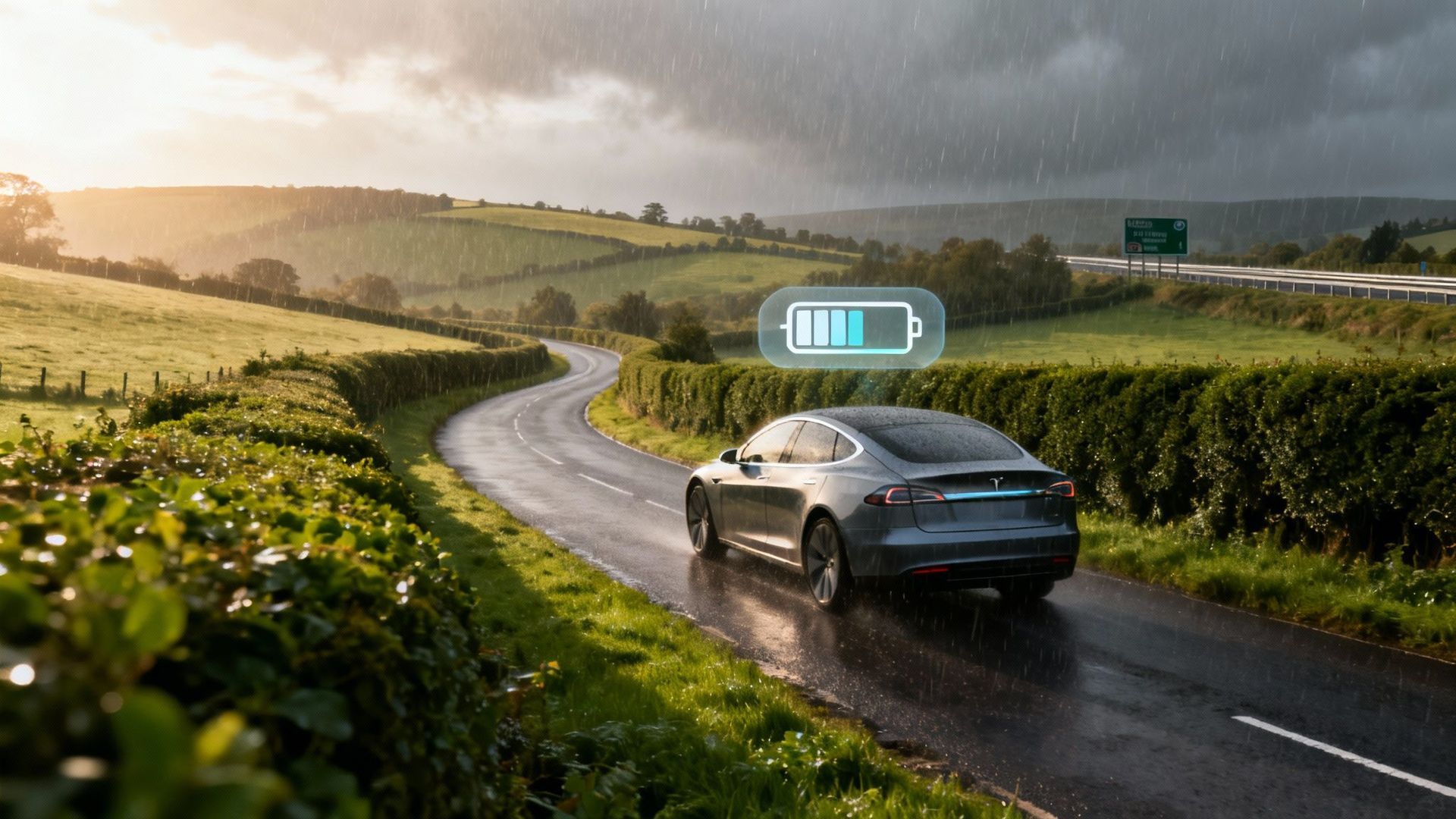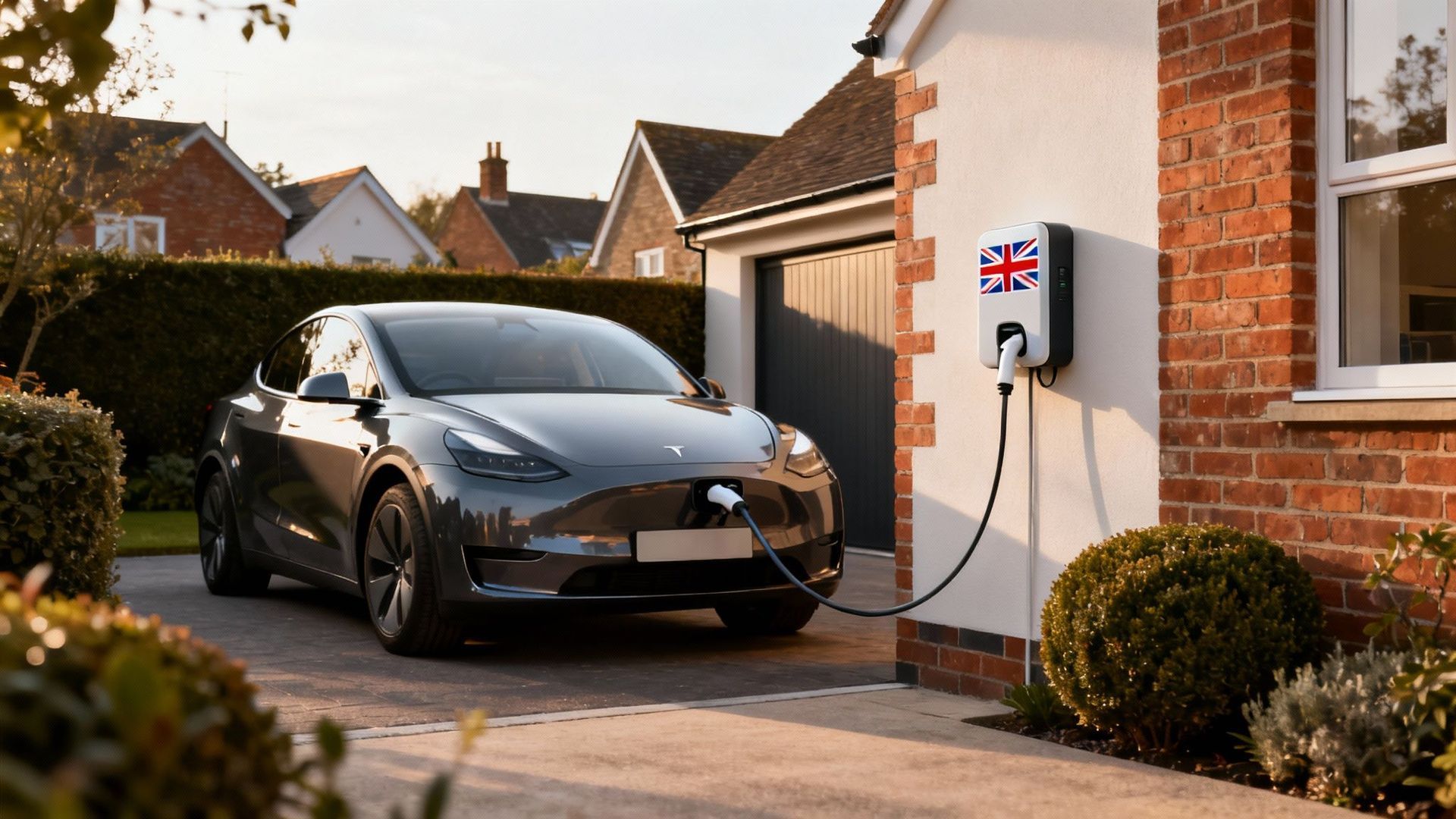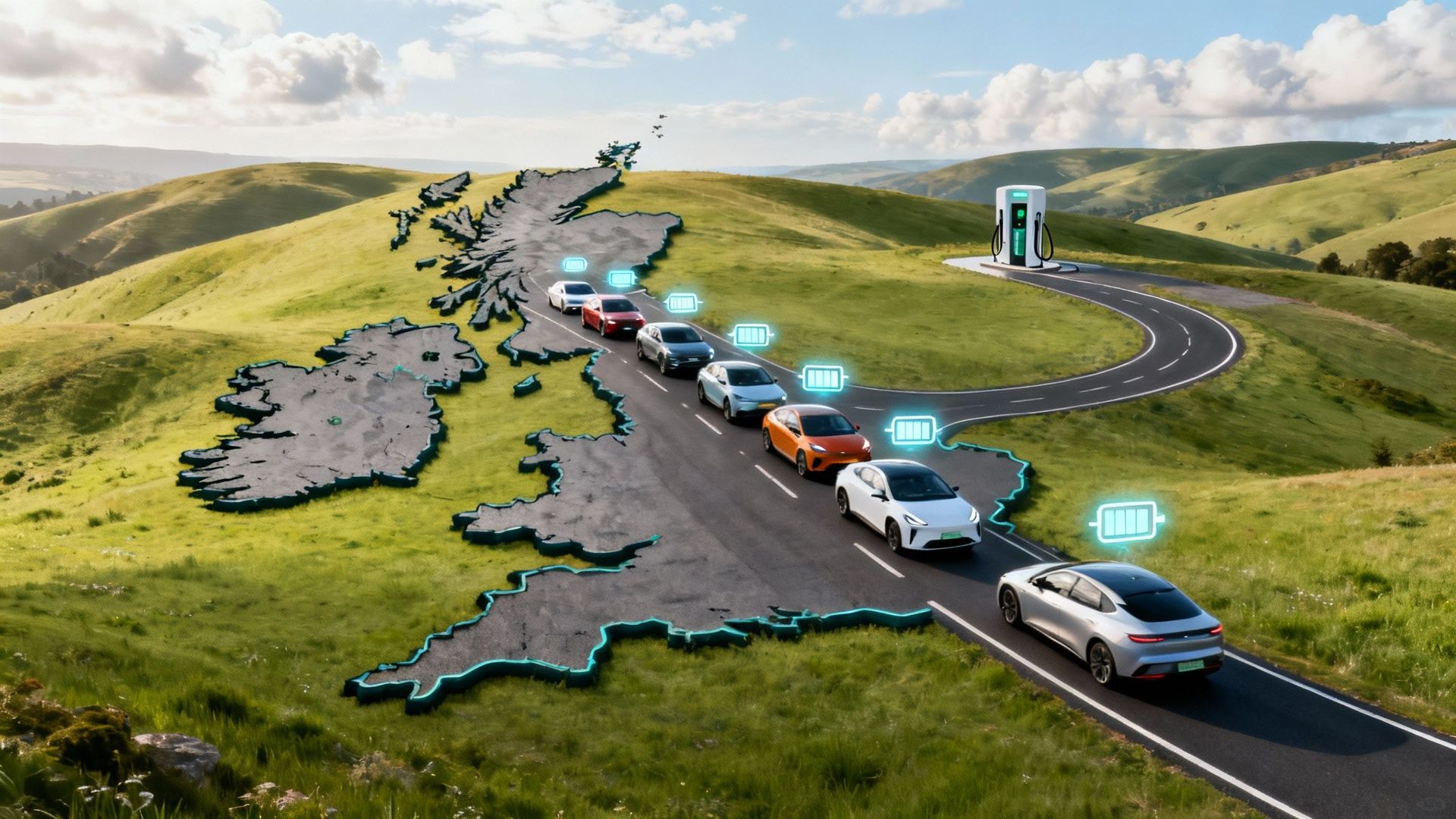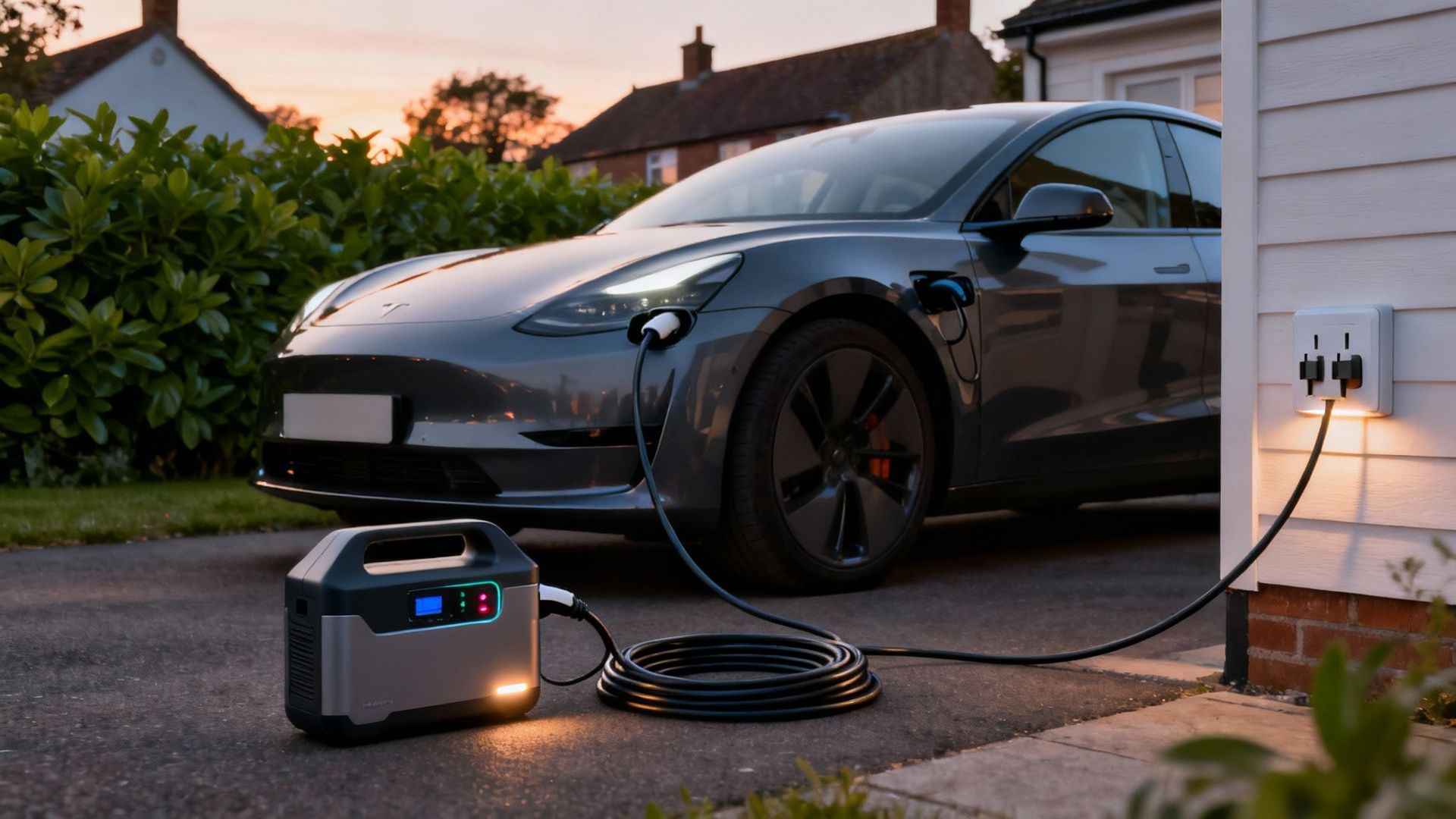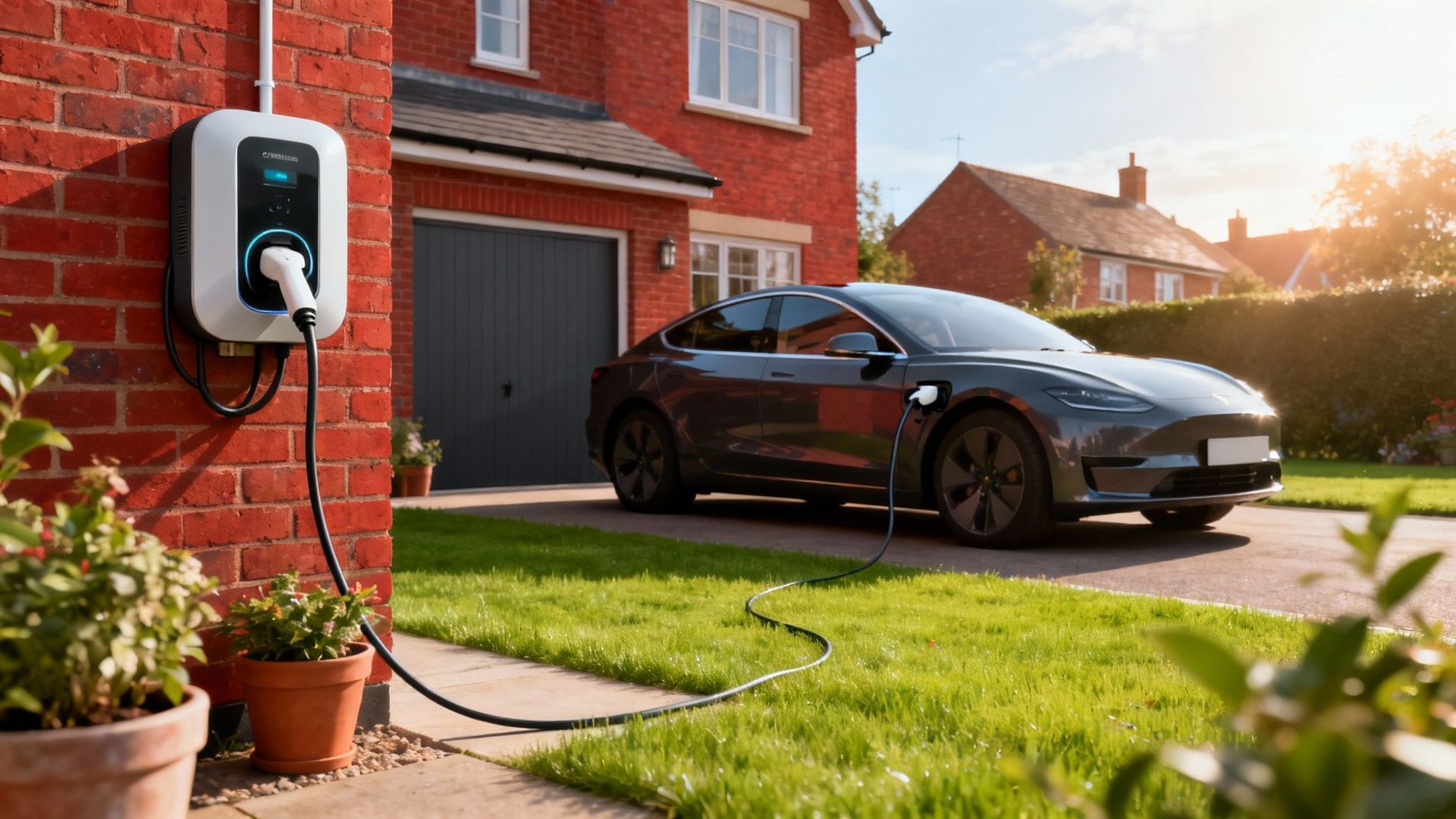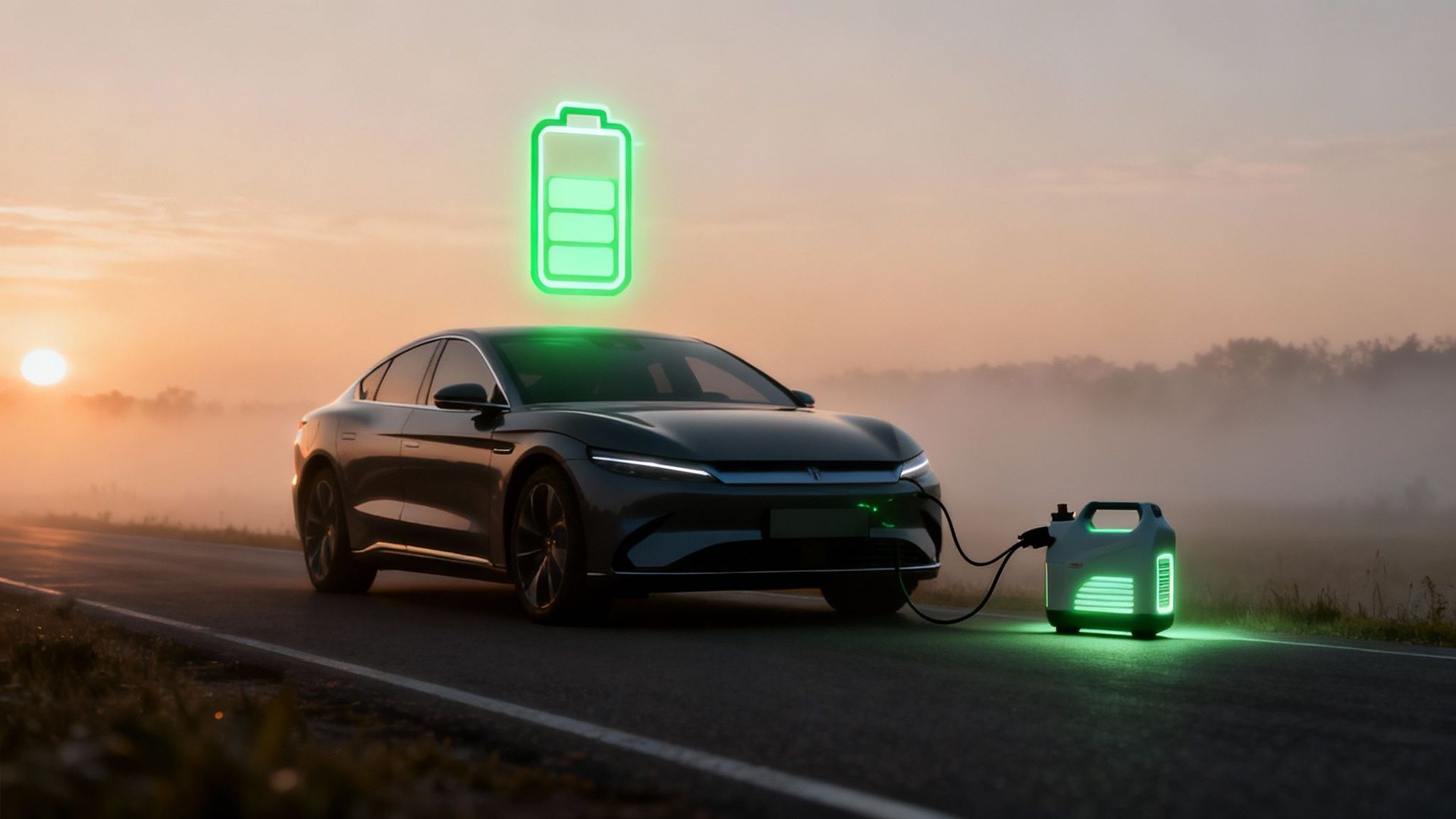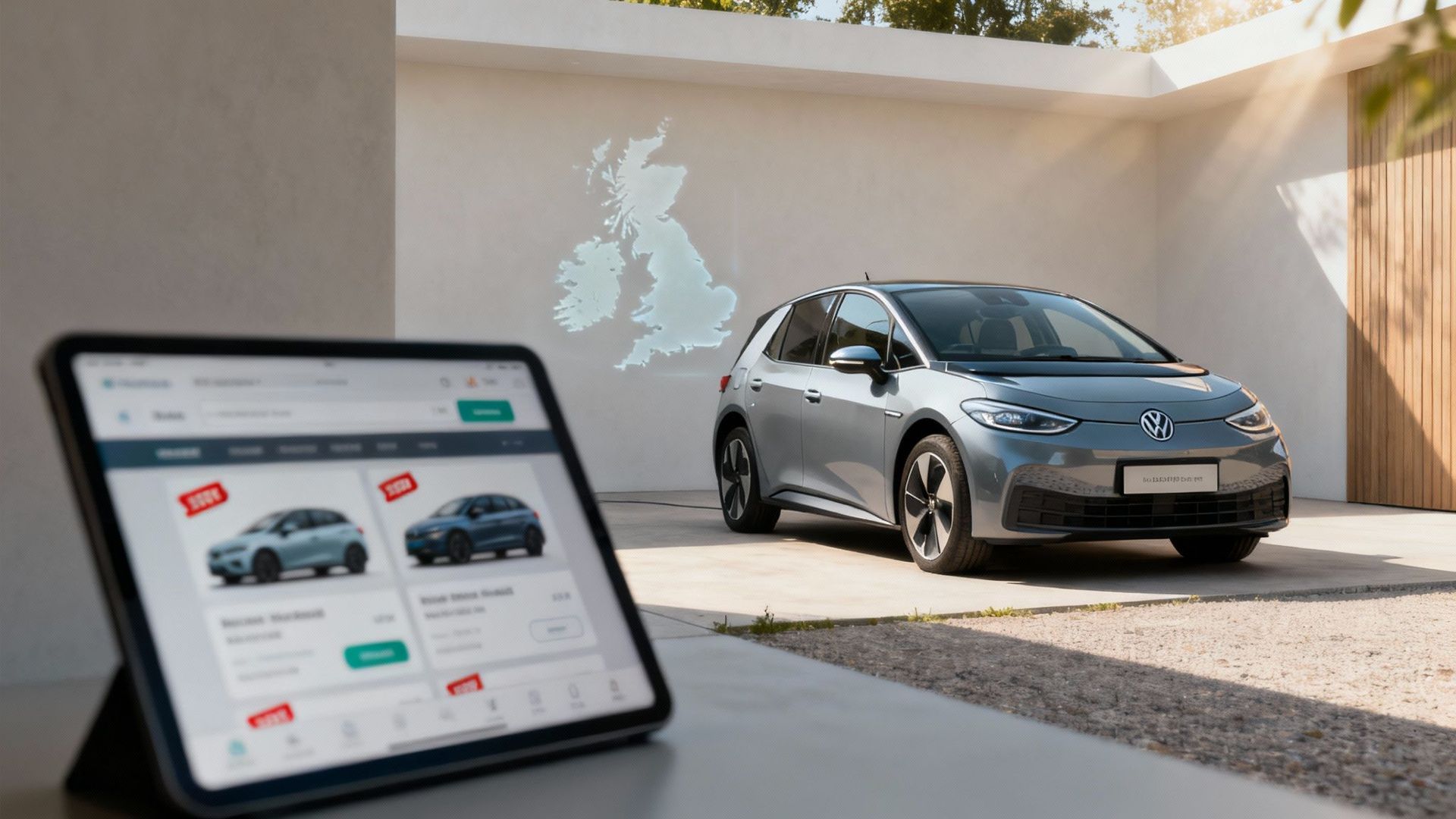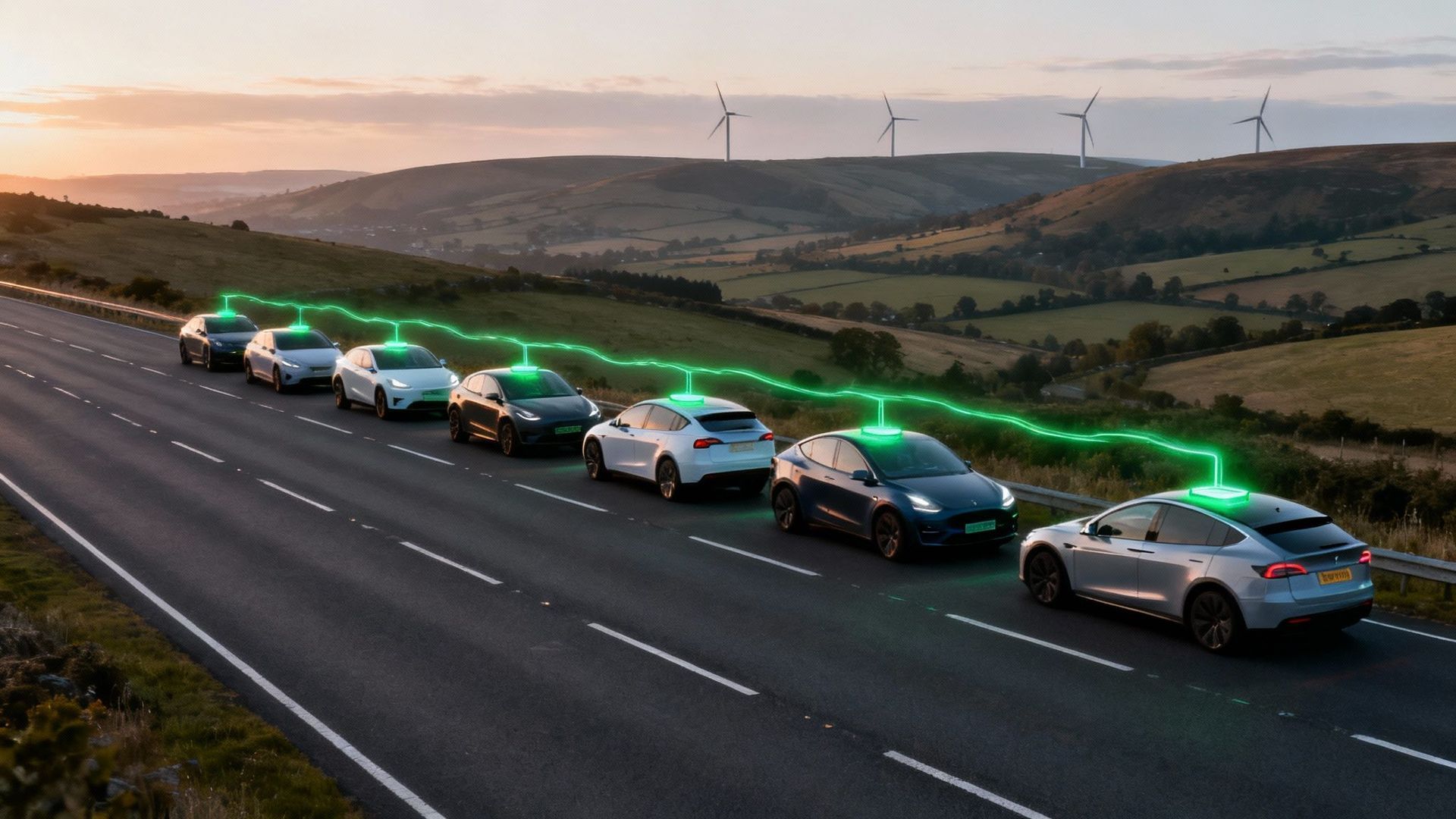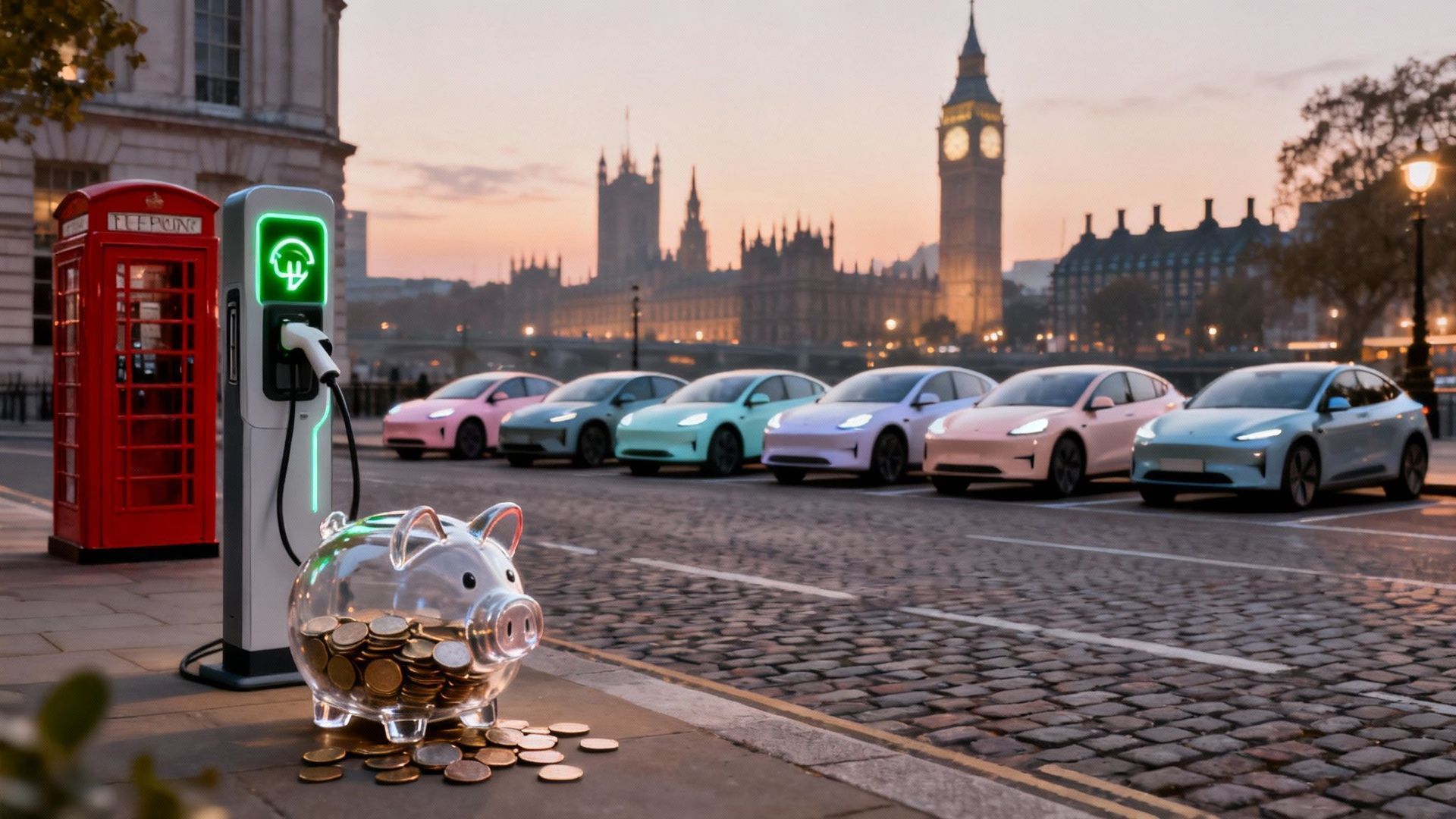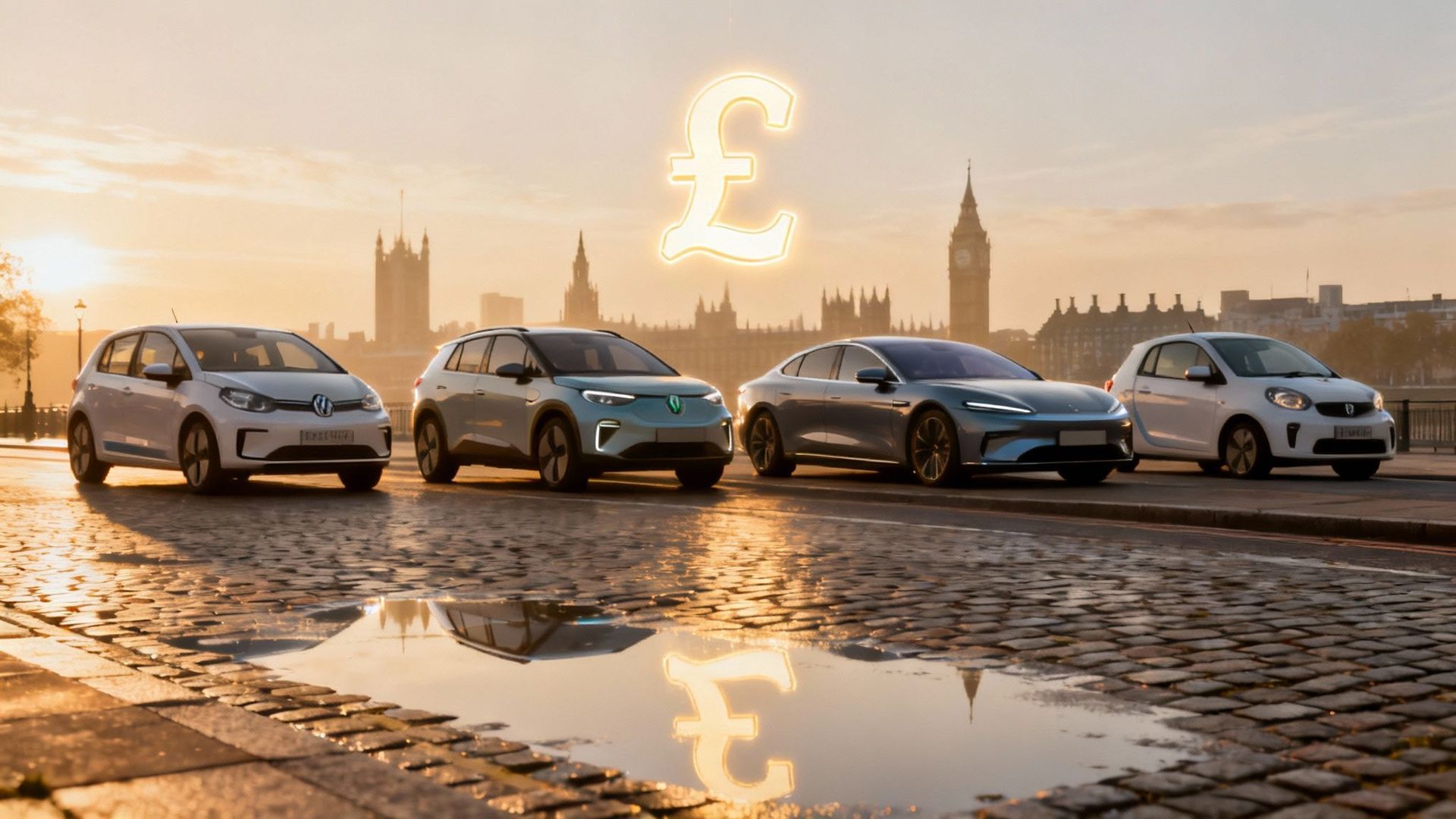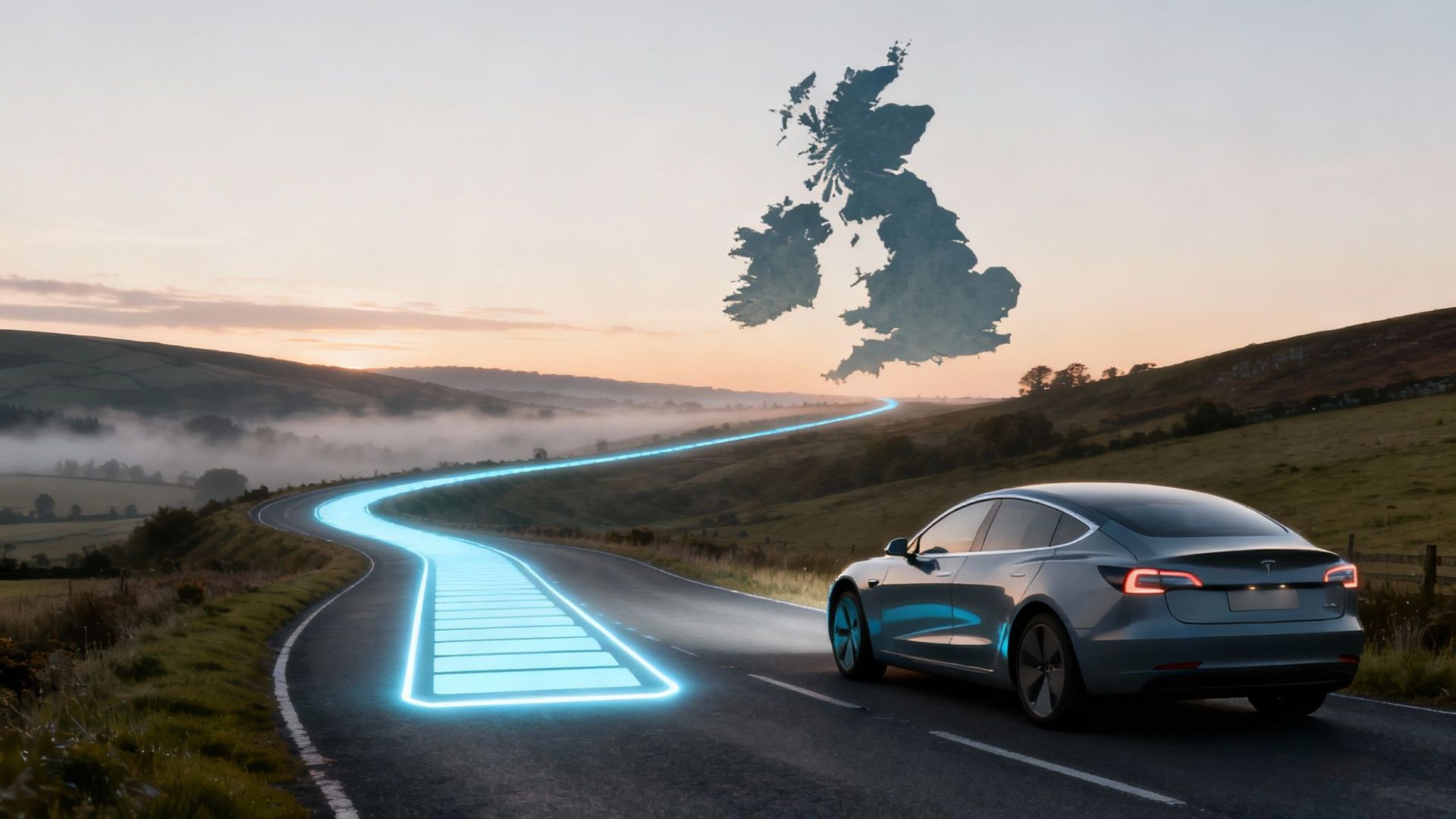A Sceptic's Guide to Electric Car Home Charging in the UK
Right then, you've done it. You’ve swapped the glorious racket of an internal combustion engine for the smug, silent hum of an electric vehicle. The future is sitting on your drive, a testament to your excellent taste and/or your susceptibility to marketing. But that warm, fuzzy feeling can evaporate pretty sharpish when you realise the thing needs feeding. Faffing about with public chargers is about as appealing as a weekend in Skegness in February, which is why electric car home charging in the UK is the only vaguely sane way to live with an EV.
Why on Earth Would I Bother With a Home Charger?

Let's cut the flannel. Relying solely on the public charging network is a mug's game. It can be eye-wateringly expensive, the chargers are frequently busted, and it often involves loitering in a poorly-lit service station car park at 10 PM, wondering where it all went wrong.
A dedicated home charger, on the other hand, is a proper game-changer. Think of it this way: you’d never drive to a petrol station every single night just to top up your old motor, so why treat your EV like some high-maintenance Tamagotchi? A home charger turns your driveway into your own private fuel station. Minus the stale Ginsters and questionable coffee.
The Sheer, Glorious Convenience of It All
The biggest win is the mind-numbing convenience. You get home, plug the car in, and that’s your lot. The next morning, you wake up to a 'full tank' of electrons, ready for whatever fresh hell the day throws at you.
No more daft diversions on the way home, no more queueing behind a Nissan Leaf that seems to have been charging since the Boer War, and absolutely no more "range anxiety." This simple routine completely transforms the EV ownership experience from a logistical nightmare into something utterly effortless. It’s how electric cars were meant to be, if you're into that sort of thing.
It's All About the Money, Darling
Beyond the bone-idleness, the cost savings are massive. Public rapid chargers can cost a pretty penny, sometimes getting uncomfortably close to the price of petrol or diesel per mile. Which sort of defeats the point.
Charging at home, especially if you get on a clever off-peak electricity tariff, can slash your "fuel" bill by up to 80% . Suddenly, those pennies-per-mile claims you scoffed at in the brochure start to feel very real.
The numbers speak for themselves. In the UK, there are an estimated 700,000 private charging locations compared to only about 84,218 public ones. Government grants from the Office for Zero Emission Vehicles (OZEV) certainly helped, knocking a decent chunk off the typical £1,000 installation cost for a standard 7kW unit.
The real luxury of an EV isn't the silent acceleration or the fancy tech; it's leaving the house every morning with a full battery, knowing you've paid buttons for it. Public charging is a backup, not a lifestyle choice.
When you're first starting out, the choice can feel overwhelming. To help you see the wood for the trees, here’s a quick breakdown of how the two charging methods stack up.
Home Charging vs Public Charging: A Smackdown
| Factor | Home Charging | Public Charging |
|---|---|---|
| Cost Per kWh | Significantly lower, especially on off-peak tariffs (e.g., 7.5p). | Much higher, particularly for rapid chargers (can be 60-80p). |
| Convenience | Unbeatable. Plug in overnight and wake up to a full battery. | Requires finding a working, available charger and waiting. |
| Charging Speed | Slower (typically 3.7kW or 7kW), but fine for overnight. | Varies from slow to ultra-rapid (22kW to 350kW). |
| Upfront Cost | An initial investment for the unit and installation is needed. | No upfront cost, but you pay a premium per charge. |
| Reliability | Your own unit, so it's always available and working for you. | Can be a lottery—chargers can be broken, in use, or blocked. |
| Best For | Daily top-ups, routine commuting, and maximum cost savings. | Long journeys, quick top-ups, and drivers without off-street parking. |
Ultimately, having your own charger at home offers a level of freedom and economy that the public network just can't match for day-to-day driving.
Deciding between the two options is a big step, but it's crucial for getting the most out of your new car. If you're still weighing it up, find out more in our guide on whether you should you invest in a home charger or stick with public networks.
Decoding Chargers Without Losing Your Sanity

Right, let's talk hardware. Diving into the world of home chargers can feel a bit like trying to order a coffee in Shoreditch. You just want a normal brew, but you’re confronted with a baffling menu of jargon.
It’s the same with EV chargers. The market is flooded with different boxes, all promising eternal happiness and zero emissions, while throwing around terms like '3kW', '7kW', 'tethered', 'untethered', and 'smart'. Consider this your no-nonsense translation guide. We'll cut through the sales waffle so you can choose the right bit of kit for your home.
Getting Up to Speed on Charger Power
First things first: speed. In the world of chargers, speed is measured in kilowatts (kW), and for home charging, you'll mainly hear about two options: the sluggish 3kW and the much more standard 7kW.
-
3kW Charger (The Tortoise): Often called a 'slow' charger, this is the equivalent of trying to fill a swimming pool with a teaspoon. It’ll add about 10-12 miles of range for every hour it’s plugged in. Honestly, unless you barely drive and have all weekend to charge, a 3kW charger is a false economy.
-
7kW Charger (The Hare): Now we're talking. This is what most people mean when they refer to a 'fast' home charger. It delivers a much more practical 25-30 miles of range per hour, making it the undisputed sweet spot for just about every UK home with a standard single-phase electricity supply (which is most of us).
A 7kW unit will comfortably recharge even the biggest EV battery from empty to full overnight. It's the sensible, default choice that fits the rhythm of daily life perfectly. Anything faster usually requires a three-phase supply, which is pretty rare in UK homes and a whole different can of worms.
This focus on slower, overnight top-ups is mirrored across the wider public network. Public chargers are split into slow (3-7kW), fast (8-49kW), rapid (50-149kW), and ultra-rapid (150kW+) categories. Interestingly, as of mid-2025, over 46,000 public units were the slower type, making up more than 55% of the total. This just shows how the whole system is built around that home charging model.
Tethered vs Untethered: The Great Cable Debate
Next up, you need to decide if you want a charger with the cable permanently attached (tethered) or a socket where you use the cable that came with your car (untethered). It sounds like a small detail, but it has a real impact on your daily routine.
An untethered charger is just a socket on the wall. It looks neater and offers a bit more flexibility—if car manufacturers ever change the plug type (unlikely, but you never know), you just buy a new cable. The big downside? You have to get your own cable out of the boot every single time you want to charge. It’s a real faff, especially when it’s hammering it down with rain.
A tethered charger has the cable hardwired right into the unit. This is all about convenience. You pull up, grab the plug, and stick it in the car. Job done. The drawback is that you have a chunky cable hanging on your wall, which isn't the prettiest sight, and you’re stuck with that specific connector.
For sheer ease of use, tethered is the hands-down winner. You'll thank yourself on every cold, dark, and miserable winter evening when you don’t have to wrestle a wet, muddy cable out of your car.
Why Your Next Charger Will Be a Smart One (Whether You Like It or Not)
Finally, let's demystify 'smart' chargers. A few years ago, these were a premium option. Now, thanks to new regulations, pretty much every new home charger installed in the UK has to be a smart one. And for good reason.
A smart charger is simply a unit that can connect to the internet. This opens up a world of clever tricks that save you money and help the grid.
- Scheduled Charging: You can tell it to only charge during specific hours, like overnight when your electricity is cheapest on a special EV tariff.
- Energy Monitoring: It tracks exactly how much electricity your car is using, giving you a crystal-clear picture of your running costs through an app.
- Grid Balancing: They can automatically adjust charging speed to help the National Grid avoid blackouts during periods of high demand.
Crucially, you’ll almost certainly need a smart charger to be eligible for any remaining government grants, particularly if you're a renter or live in a flat. They are the absolute key to unlocking the cheapest running costs and turning your EV into a genuinely money-saving machine. For a deeper look into the broader network, check out our guide on the EV charging landscape in the UK.
Navigating the Grant Minefield
Ah, government grants. The very phrase can bring on a headache, conjuring up images of endless paperwork and bureaucratic hoops. But when it comes to getting an EV home charger in the UK, the government's OZEV grant is a genuinely helpful discount—if you can be bothered to jump through the right hoops.
Let's get one thing straight from the start: the days when almost any Tom, Dick, or Harriet with an EV could get a grant are long gone. The rules have changed, and the focus is now squarely on helping those who face the biggest hurdles to installing a home charger. It's less about a cheap deal and more about making home charging a reality for everyone.
So, Who Actually Qualifies for a Handout Now?
The eligibility criteria have definitely been tightened up. If you're a homeowner in a typical detached or semi-detached house with your own private driveway, you likely won't qualify anymore. Tough luck.
The scheme now targets two main groups:
- Renters: If you rent your property (and, crucially, have your landlord's permission), you can still apply. This goes for both houses and flats.
- Flat Owners/Dwellers: Anyone who owns or lives in a flat is also a priority. The grant is there to help tackle the common issues of shared car parks and tricky wiring that apartment blocks often present.
The grant itself is worth up to £350 towards the cost of the charger and its installation. It's not going to make it free, but that’s a significant chunk of change that makes the initial cost much easier to swallow.
The bottom line is this: the grant is no longer a universal perk for EV drivers. It's targeted support for people whose properties make a straightforward installation—like drilling a hole through a garage wall—a lot more complicated.
This handy infographic gives you a good idea of the typical installation journey, from the first survey right through to getting your new charger up and running.

As you can see, it’s a methodical process. The great news is that your installer handles the grant application for you as part of their work, assuming you’re eligible.
The Non-Negotiable Rules of the Game
Getting the grant isn't just about where you live; it's also about who you hire and what they install. There are a couple of hard-and-fast rules you simply can't get around.
First, your installer must be OZEV-approved. This isn't just a recommendation. If you get your mate Dave the electrician to fit a charger for you, you won't get a penny. The scheme is all about ensuring every installation is safe and meets the proper standards, which is why only certified professionals can claim the grant on your behalf.
Second, the charge point itself has to be on the OZEV-approved list. Don't worry, this isn’t some obscure list of unheard-of brands. It includes pretty much every well-known smart charger on the UK market. Your installer will know exactly which models are eligible and will guide you.
How to Stay Off the Application Rejection Pile
Thankfully, the process is pretty straightforward because your chosen installer does most of the legwork. But that doesn't mean it's foolproof. Applications can still be rejected for surprisingly simple reasons.
Here’s what you need to have ready to avoid any hiccups:
- Proof of Property: You’ll need to show that you live where you say you do and that you either rent the property or own/live in a flat. A tenancy agreement or title deeds will do the trick.
- Proof of EV: You have to prove you have an eligible electric vehicle. This can be your V5C logbook or even just the order confirmation for a new car.
- Parking Permission: You must have a designated off-street parking space. If you're renting, you'll also need written permission from your landlord or property management company for the installation.
Think of it as a checklist. If you find an approved installer and have the right documents ready to go, that £350 discount should be yours.
Even though the main grant for homeowners has ended, it's not the disaster it might seem. You can learn more about its history and why it's not the end of the world by reading our take on the UK government EV grant being gone.
What to Expect on Installation Day (Apart from Tea and Biscuits)
So, you’ve picked your charger, navigated the grant system, and now the big day is looming. A couple of electricians are about to turn up at your door, armed with drills and a big box of wires. What actually happens next?
Don't just make them a cuppa and hide indoors. Understanding the installation process is the final, crucial step to avoiding any nasty surprises. This isn’t just about getting a box screwed to a wall; it’s a proper bit of electrical work.
The Myth of the 'Standard Installation'
Every company will quote you for a 'standard installation' . This sounds lovely and straightforward, but the term carries more caveats than a budget airline ticket. Knowing what it usually covers—and more importantly, what it doesn't—is key.
A standard installation typically assumes:
- A short cable run: Usually up to 10 metres of cable from your consumer unit (that’s your fuse box) to the charger’s location.
- Easy drilling: A straightforward job through a standard brick or block wall.
- A modern consumer unit: Your existing fuse box has to have enough space and be up to current safety standards.
- No groundwork: The cable will be neatly clipped to an existing wall, not buried in a trench across your prize-winning lawn.
Anything that falls outside this neat little box is likely to cost you extra. The initial site survey, whether done remotely with photos or in person, is where these potential issues should be flagged.
Your installer's definition of "standard" and yours might be two very different things. The pre-installation survey is your golden opportunity to get everything in writing and nail down the final price before a single hole is drilled.
Dodging the Extra Costs
The final bill can quickly creep up if your property is a bit, shall we say, 'characterful'. These are the most common culprits for extra charges, so be prepared to discuss them with your installer.
A new consumer unit is a big one. If yours looks like something out of a 1970s museum and lacks modern safety features like an RCD (Residual Current Device) , it will almost certainly need upgrading. This can add several hundred pounds to the job but is a non-negotiable safety requirement.
Another common issue is a long or complex cable run. If your fuse box is at the front of the house but you want the charger by a detached garage at the bottom of the garden, that's a lot of armoured cable and a lot of extra labour. Likewise, drilling through 2-foot thick stone walls is a world away from popping through a single brick wall.
The Great Earth Rod Debate
Now for a bit of technical nitty-gritty that’s actually worth understanding: earthing. For safety, your charger needs a reliable earth connection. Traditionally, this meant hammering a massive copper spike, known as an earth rod , into the ground near your charger.
This works, but it’s a bit messy and not always practical.
Thankfully, modern chargers have a much smarter solution built-in called PEN fault detection . This clever tech constantly monitors your home's electrical supply. If it detects a rare but dangerous fault with the incoming earth connection, it shuts the charger down instantly. It does the same job as an earth rod but without needing any impromptu gardening. Most modern chargers have this built-in, making for a tidier and often simpler installation.
Key Questions to Grill Your Installer With
When the installer is doing their survey, don't be shy. This is your chance to get clarity and avoid any "oh, by the way..." conversations on installation day.
Arm yourself with these questions:
- Is this quote for a 'standard installation' and can you confirm my property fits that criteria? Get them to explicitly state what's included.
- Where will the cable run from the consumer unit to the charger? Make sure you're happy with the route. You don't want a thick black cable running over your fancy new porch.
- Will you need to install an earth rod, or does the charger have built-in PEN fault detection? This confirms they are using modern, compliant hardware.
- Is my current consumer unit suitable, or will it need upgrading? Get a clear 'yes' or 'no' on this to avoid a surprise cost.
- What is the final, all-inclusive price for the job you've quoted? Pin them down. A verbal quote is fine, but a written one is much, much better.
Being prepared for installation day turns it from a potentially stressful experience into an exciting one. It’s the day your home gets its final upgrade, making your transition to electric motoring complete and putting you in full control of your electric car home charging UK setup.
Living With Your Home Charger (Without it Driving You Mad)
Your shiny new charger is proudly fixed to the wall, the electricians have tidied up, and your car is plugged in. Job done, right? Not quite. Getting the box installed is one thing; weaving it smoothly into your daily life is another.
This is where you go from being a rookie EV owner to a seasoned pro. The goal is to make your home charging so utterly forgettable that you never have to think about it. It should just… work. Let's get into the nitty-gritty of day-to-day life with your new electric fuel pump.
Mastering Your Charger's Brain
That smart charger on your wall is much more than a glorified plug socket. It comes with an app, and learning your way around it is the key to unlocking serious savings and convenience. Don't just leave it on the default settings and hope for the best.
The single most important feature you need to get to grips with is scheduled charging . Your electricity provider will almost certainly offer a special EV tariff with ridiculously cheap overnight rates. By diving into your charger's app, you can tell it to only deliver juice during these off-peak hours, which are typically between midnight and 5 AM. This is the secret sauce to those mythical 2p-per-mile running costs.
Forgetting to set a schedule is like buying a Ferrari and only driving it in first gear. You're leaving the best part of the experience—and a massive pile of cash—on the table.
Everyday Habits of a Happy EV Driver
Living with a home charger means making a few small shifts in your routine. Get these right, and you'll soon wonder how you ever managed without them.
- Plug in, every time. Make it a habit. Get home, get out of the car, plug it in. Even if the battery is at 80%, just do it. This simple action avoids that soul-crushing moment you wake up to find you forgot, with only 15 miles of range for a 50-mile commute.
- Keep your cable tidy. If you have a tethered charger, use the built-in holster or a simple wall hook. Leaving a 5-metre cable coiled on the ground is a trip hazard, looks messy, and is just asking to be driven over.
- Set a charge limit. Most EVs let you set a maximum charge level, usually around 80% for daily use. Constantly charging to 100% can degrade the battery's health over the long term. Save the full-whack charge for those long road trips.
- Charging Etiquette 101. If you share a drive or have two EVs, a bit of communication goes a long way. A simple "Do you need a top-up tonight?" can prevent a domestic squabble over who gets the plug.
Common Blunders to Sidestep
We all make mistakes, but some are more inconvenient (and expensive) than others. Here are a few classic EV novice errors you’ll want to avoid.
One of the most common is misjudging your next day's journey. If you know you've got a long drive to a client meeting tomorrow, override the usual 80% limit and charge to 100% . Don't get caught short just because you were running on autopilot.
Another classic is getting your off-peak times wrong. Double-check your energy tariff. Setting your charger to fill up between 1 AM and 6 AM when your cheap rate actually ends at 5:30 AM is a painfully easy way to pay peak prices for 30 minutes of electricity.
The UK's charging infrastructure has grown enormously, but home charging is still the bedrock of daily EV life. Recent data shows that while public charging sessions hit over 7.6 million in early 2025, a massive 700,000 private home chargers do the bulk of the work. This reliance on home charging is particularly strong in urban hubs like Greater London, which accounts for 22% of public charging use. It shows that even where public options are plentiful, home is where the charging happens for most people. You can learn more about EV market stats and trends in the UK.
Ultimately, integrating an electric car charger into your home life is about building simple, repeatable habits. Once you’ve mastered the app and established a routine, you’ll achieve the ultimate goal: complete and utter charging invisibility.
Still Got Questions? We’ve Got Answers

It’s completely normal to have a few questions buzzing around your head at this point. Getting an EV charger installed is a big step, and it's smart to iron out any lingering uncertainties before you commit.
Let’s run through some of the most common queries we hear from drivers making the switch. We'll give you straight, practical answers to help you feel confident about your decision.
Do I Need Planning Permission for a Home Charger?
Let's get the easy one out of the way first. For the vast majority of homeowners in the UK, the answer is a simple no .
Installing a home charge point generally falls under 'permitted development rights', meaning you don't need to go through the hassle of a planning application. Of course, there are a few common-sense conditions. The unit can't be installed on the side of a listed building without consent, for instance, and it can't face a public highway if it's not in your driveway.
But honestly, as long as you aren’t planning on something completely outlandish, you’re in the clear. Your installer will be well-versed in all the local rules and will ensure everything is above board, so this is one bit of admin you can safely leave to the pros.
Can My House’s Wiring Actually Handle a 7kW Charger?
This is a fantastic question and a crucial one. Most modern UK homes are more than capable of handling a standard 7kW charger, which is the sweet spot for overnight charging.
The key factors are your home's main fuse (usually 100 amps ) and the condition of your consumer unit (or fuse box, in old money). Before any installation work begins, a qualified electrician will carry out a survey to check everything over. They'll assess your current setup and confirm it can safely support the new load.
If they find anything that's not up to scratch, like an old-fashioned fuse box or an undersized main fuse, they’ll explain exactly what needs to be upgraded to get you ready for your new charger.
This isn't just a box-ticking exercise. A proper survey is vital to ensure the installation is safe and won't cause any electrical headaches down the line. It's an absolute must.
How Much Does Home Charging Add to My Electricity Bill?
Ah, the million-dollar question! The impact on your electricity bill can range from "barely noticeable" to "ouch," and it all comes down to when you charge.
If you simply plug your car in at 6 PM when you get home from work, you'll be charging at peak rates. Do that consistently, and you will definitely see a hefty jump in your monthly bill.
The real game-changer is switching to an EV-friendly energy tariff. These tariffs offer incredibly cheap electricity during off-peak hours, typically between midnight and 5 AM. With rates as low as 7.5p per kWh , you could be paying as little as 2p per mile . At that price, a full charge for a family-sized EV might only set you back a fiver. It’s a world away from the cost of petrol, and significantly cheaper than most public chargers.
What Happens if There’s a Power Cut?
It’s a valid concern: you set your car to charge overnight, only to be woken by a power cut. The good news is, it's rarely the drama you might imagine.
Your charger obviously won't work during the outage itself. However, any decent smart charger is designed to handle this. As soon as the power is restored, it will automatically resume the charging session right where it left off, following the schedule you've set.
So, unless you have a prolonged blackout that lasts the entire night, you'll still wake up to a car with more than enough range for your morning commute.
For more honest, no-nonsense EV reviews, guides, and industry news, check out the latest content from VoltsMonster at https://www.voltsmonster.com.

